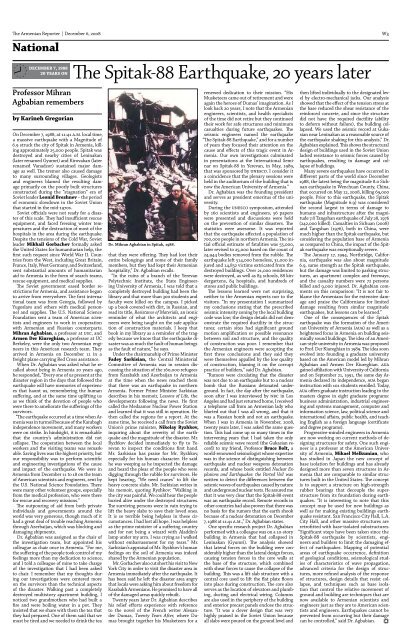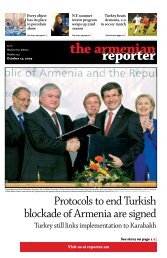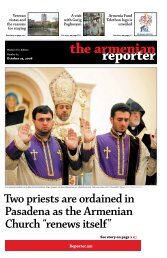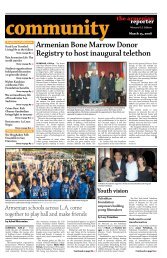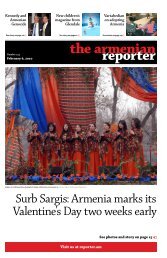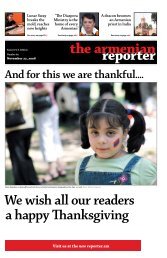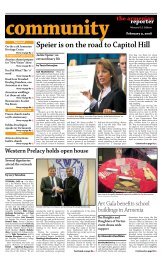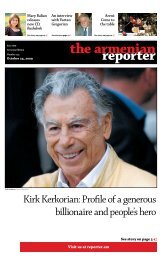National, International, Armenia, and Community News and Opinion
National, International, Armenia, and Community News and Opinion
National, International, Armenia, and Community News and Opinion
You also want an ePaper? Increase the reach of your titles
YUMPU automatically turns print PDFs into web optimized ePapers that Google loves.
The <strong>Armenia</strong>n Reporter | December 6, 2008<strong>National</strong>W3December 7, 198820 years onThe Spitak-88 Earthquake, 20 years laterProfessor MihranAgbabian remembersby Karineh GregorianOn December 7, 1988, at 11:41 a.m. local time,a massive earthquake with a Magnitude of6.9 struck the city of Spitak in <strong>Armenia</strong>, killingapproximately 25,000 people. Spitak wasdestroyed <strong>and</strong> nearby cities of Leninakan(later renamed Gyumri) <strong>and</strong> Kirovakan (laterrenamed Vanadzor) sustained major damageas well. The tremor also caused damageto many surrounding villages. Geologists<strong>and</strong> engineers blamed the resulting damageprimarily on the poorly built structuresconstructed during the “stagnation” era ofSoviet leader Leonid Brezhnev – the periodof economic slowdown in the Soviet Unionthat started in the mid-1970s.Soviet officials were not ready for a disasterof this scale. They had insufficient rescueequipment, <strong>and</strong> faced freezing winter temperatures<strong>and</strong> the destruction of most of thehospitals in the area during the earthquake.Despite the tensions of the Cold War, Sovietleader Mikhail Gorbachev formally askedthe United States for humanitarian help, thefirst such request since World War II. Countriesfrom the West, including Great Britain,France, Italy, West Germany, <strong>and</strong> Switzerl<strong>and</strong>,sent substantial amounts of humanitarianaid to <strong>Armenia</strong> in the form of search teams,rescue equipment, <strong>and</strong> medical supplies.The Soviet government eased border restrictionsfor <strong>Armenia</strong>, <strong>and</strong> assistance beganto arrive from everywhere. The first internationalteam was from Georgia, followed byYugoslavs <strong>and</strong> others with medical personnel<strong>and</strong> supplies. The U.S. <strong>National</strong> ScienceFoundation sent a team of American scientists<strong>and</strong> engineers to work in cooperationwith <strong>Armenia</strong>n <strong>and</strong> Russian counterparts.Mihran Agbabian, a professor at USC, <strong>and</strong>Armen Der Kiureghian, a professor at UCBerkeley, were the only two <strong>Armenia</strong>n engineersin this American research team. Theyarrived in <strong>Armenia</strong> on December 11 in afreight plane carrying Red Cross assistance.When Dr. Agbabian was asked what he recalledabout being in <strong>Armenia</strong> 20 years ago,he responded, “Every one of us present at thedisaster region in the days that followed theearthquake will have memories of experiencesthat haunt us, remembering the humansuffering, <strong>and</strong> at the same time uplifting usas we think of the devotion of people whowere there to ameliorate the sufferings of thesurvivors.“The earthquake occurred at a time when <strong>Armenia</strong>was in turmoil because of the Karabaghindependence movement, <strong>and</strong> many workerswere on strike. In hindsight, it is remarkablethat the country’s administration did notcollapse. The cooperation between the localworkers <strong>and</strong> the visiting teams was remarkable.Saving lives was the highest priority, butour responsibility was to perform scientific<strong>and</strong> engineering investigations of the cause<strong>and</strong> impact of the earthquake. We were in<strong>Armenia</strong> from December 11 to 18 on the teamof American scientists <strong>and</strong> engineers, sent bythe U.S. <strong>National</strong> Science Foundation. Therewere many other volunteer groups, especiallyfrom the medical profession, who were therefor rescue <strong>and</strong> recovery missions.”The outpouring of aid from both privateindividuals <strong>and</strong> governments around theworld was very generous, though much of ithad a great deal of trouble reaching <strong>Armenia</strong>through Azerbaijan, which was blocking <strong>and</strong>damaging shipments.Dr. Agbabian was assigned as the chair ofthe investigation team, but appointed hiscolleague as chair once in <strong>Armenia</strong>. “For me,the suffering of the people took control of myfeelings more than my dedication to science,<strong>and</strong> I told a colleague of mine to take chargeof the investigation that I had been askedto chair. I remember that my thoughts duringour investigations were centered moreon the survivors than the technical aspectsof the disaster. Walking past a completelydestroyed multistory apartment building, Inoticed two gr<strong>and</strong>mothers who had built afire <strong>and</strong> were boiling water in a pot. Theyinsisted that we share with them the tea thatthey had prepared. One of them said that wemust be tired <strong>and</strong> we needed to drink the teaDr. Mihran Agbabian in Spitak, 1988.that they were offering. They had lost theirentire belongings <strong>and</strong> some of their familymembers, but they had kept their <strong>Armenia</strong>nhospitality,” Dr. Agbabian recalls.“In the ruins of a branch of the YerevanPolytechnic Institute, the State EngineeringUniversity of <strong>Armenia</strong>, I was told that acompletely destroyed building had been thelibrary <strong>and</strong> that more than 300 students <strong>and</strong>faculty were killed on the campus. I pickedup a book covered with dirt, in Russian, <strong>and</strong>read its title, Resistance of Materials, an ironicreminder of what the architects <strong>and</strong> engineerswere being taught on the safe applicationof construction materials. I keep thatbook in my library as a reminder of the tragedybecause we know that the earthquake disasterwas as much the fault of human beingsas the fault of nature,” he says.Under the chairmanship of Prime MinisterFadey Sarkisian, the Central MinisterialCommittee of <strong>Armenia</strong> was in session discussingthe situation of the 160,000 refugeesfrom Karabakh <strong>and</strong> Azerbaijan to <strong>Armenia</strong>at the time when the news reached themthat there was an earthquake in northern<strong>Armenia</strong>. Former Prime Minister Sarkisi<strong>and</strong>escribes in his memoir, Lessons of Life, thedevelopments following the news. He firstcalled the Medzamor Nuclear Power Station<strong>and</strong> learned that it was still in operation. Hethen called the regions for a report. At thesame time, he received a call from the SovietUnion’s prime minister, Nikolay Ryzhkov,inquiring about the severity of the earthquake<strong>and</strong> the magnitude of the disaster. Mr.Ryzhkov decided immediately to fly to Yerevanto inspect the conditions first h<strong>and</strong>.Mr. Sarkisian has praise for Mr. Ryzhkov,especially for his human character. He saidhe was weeping as he inspected the damage<strong>and</strong> heard the pleas of the people who weredigging through the rubble for survivors. Hekept hearing, “We need cranes” to lift theheavy concrete slabs. Mr. Sarkisian writes inhis memoir, quoting Ryzhkov: “Walking inthe city was painful. We could hear the peopleburied alive under the destroyed structures.The surviving persons were in vain trying tolift the heavy slabs to save their loved ones.It is so terrible being helpless in these circumstances.I had lost all hope. I was helplessas the prime minister of a suffering country<strong>and</strong> for not being a wizard with Aladdin’slamp under my arm. I was crying as I walkedwithout embarrassment for my tears.” Mr.Sarkisian’s appraisal of Mr. Ryzhkov’s humanfeelings on the soil of <strong>Armenia</strong> was indeedshared by the <strong>Armenia</strong>n population.Mr. Gorbachev also cut short his visit to NewYork City in order to visit the disaster area in<strong>Armenia</strong> immediately after the earthquake. Ithas been said he left the disaster area angrythat locals were asking him about freedom forKarabakh <strong>Armenia</strong>ns. He promised to have allof the damaged areas quickly rebuilt.Twenty years later Dr. Agbabian describeshis relief efforts experience with referenceto the novel of the French writer Alex<strong>and</strong>erDumas, Twenty Years After, where Dumasbrought together his Musketeers for arenewed dedication to their mission. “HisMusketeers came out of retirement <strong>and</strong> wereagain the heroes of Dumas’ imagination. As Ilook back 20 years, I note that the <strong>Armenia</strong>nengineers, scientists, <strong>and</strong> health specialistsof the time did not retire but they continuedtheir work for safe structures <strong>and</strong> minimumcasualties during future earthquakes. Theseismic engineers named the earthquake“The Spitak-88 Earthquake,” <strong>and</strong> for a numberof years they focused their attention on thecause <strong>and</strong> effects of this tragic event in <strong>Armenia</strong>.Our own investigations culminatedin presentations at the <strong>International</strong> Seminaron Spitak-88 in Yerevan, in May, 1989,that was sponsored by UNESCO. I consider ita coincidence that the plenary sessions wereheld in the auditorium of the building that isnow the American University of <strong>Armenia</strong>.”Dr. Agbabian was the founding president<strong>and</strong> serves as president emeritus of the university.During the UNESCO symposium, attendedby 160 scientists <strong>and</strong> engineers, 56 paperswere presented <strong>and</strong> discussions were heldon the prevention of similar disasters. Thestatistics were awesome. It was reportedthat the earthquake affected a population of700,000 people in northern <strong>Armenia</strong>. The initialofficial estimate of fatalities was 55,000,later revised to 25,000 based on the count of24,944 bodies removed from the rubble. Theearthquake left 514,000 homeless, 31,000 injured<strong>and</strong> 14,832 victims extricated from thedestroyed buildings. Over 21,000 residenceswere destroyed, as well as 83 schools, 88 kindergartens,84 hospitals, <strong>and</strong> hundreds ofstores <strong>and</strong> public buildings.The lessons learned were not surprising,neither to the <strong>Armenia</strong>n experts nor to thevisitors. “In my presentation I summarizedmy conclusions stating that the prescribedseismic intensity zoning by the local buildingcode was low; the design details did not demonstratethe required ductility in the structures;certain sites had significant groundmotion amplification or possible resonancebetween soil <strong>and</strong> structure, <strong>and</strong> the qualityof construction was poor. I remember thatthe <strong>Armenia</strong>n engineers were accepting thefirst three conclusions <strong>and</strong> they said theywere themselves appalled by the low qualityof construction, blaming it on the corruptpractice of builders,” said Dr. Agbabian.“Rumors were circulating that the disasterwas not due to an earthquake but to a nuclearbomb that the Russians detonated underground.In fact, the day after the earthquake,soon after I was interviewed by NBC in LosAngeles <strong>and</strong> had just returned home, I receiveda telephone call from an <strong>Armenia</strong>n lady whoblurted out that I was all wrong, <strong>and</strong> that itwas a Russian bomb <strong>and</strong> not an earthquake.When I was in <strong>Armenia</strong> in November, 2008,twenty years later, I was asked the same question.This had come up so many times in theintervening years that I had taken the onlyreliable seismic wave record (the Gukasian record)to my friend, Professor Bruce Bolt, aworld-renowned seismologist whose expertisewas in the science of distinguishing betweenearthquake <strong>and</strong> nuclear weapons detonationrecords, <strong>and</strong> whose book entitled Nuclear Explosions<strong>and</strong> Earthquakes: the Parted Veil waswritten to detect the differences between theseismic waves of earthquakes caused by nature<strong>and</strong> underground nuclear tests. He assured methat it was very clear that the Spitak-88 eventwas an earthquake record. Remote records inother countries had also proven that there wasno basis for the rumors that the earth shookbecause of a nuclear detonation on December7, 1988 at 11:41 a.m.,” Dr. Agbabian states.One specific research project Dr. Agbabianperformed with a colleague was on a 10-storybuilding in <strong>Armenia</strong> that had collapsed inLeninakan (Gyumri). The analysis showedthat lateral forces on the building were considerablyhigher than the lateral design forces,causing tension forces in the core walls atthe base of the structure, which combinedwith shear forces to cause the collapse of thebuilding. This was a lift slab structure with acentral core used to lift the flat plate floorsinto place during construction. The core alsoserves as the location of elevators <strong>and</strong> plumbing,ducting <strong>and</strong> electrical wiring. Columnsare also used in the periphery of the building<strong>and</strong> exterior precast panels enclose the structure.“It was a clever design that was veryhighly praised in the Soviet Union becauseall slabs were poured on the ground level <strong>and</strong>then lifted individually to the designated levelby electro-mechanical jacks. Our analysisshowed that the effect of the tension stress atthe base reduced the shear resistance of thereinforced concrete, <strong>and</strong> since the structuredid not have the required ductility (abilityto deform without failure), the building collapsed.We used the seismic record at Gukasiannear Leninakan as a reasonable source ofthe earthquake shaking for this analysis,” Dr.Agbabian explained. This shows the structuraldesign of buildings used in the Soviet Unionlacked resistance to seismic forces caused byearthquakes, resulting in damage <strong>and</strong> collapseof buildings.Many severe earthquakes have occurred indifferent parts of the world since December1988, the latest being the magnitude 8.0 Sichuanearthquake in Wenchuan County, China,that occurred on May 12, 2008, killing 69,000people. Prior to this earthquake, the Spitakearthquake (Magnitude 6.9) was consideredthe second largest in terms of damage tohumans <strong>and</strong> infrastructure after the magnitude7.8 Tangshan earthquake of July 28, 1976(242,000 killed). Casualties in Sichuan (2008)<strong>and</strong> Tangshan (1976), both in China, weremuch higher than the Spitak earthquake, butconsidering the population base of <strong>Armenia</strong>as compared to China, the impact of the Spitakearthquake was exceptionally severe.The January 17, 1994, Northridge, California,earthquake was also about magnitude6.9, same strength as the Spitak earthquake,but the damage was limited to parking structures,an apartment complex <strong>and</strong> freeways,<strong>and</strong> the casualty numbers were 72 personskilled <strong>and</strong> 9,000 injured. Dr. Agbabian commentson this comparison: “It is not fair toblame the <strong>Armenia</strong>ns for the extensive damage<strong>and</strong> praise the Californians for limiteddamage resulting from similar magnitudeearthquakes, but lessons can be learned.”One of the consequences of the Spitakearthquake was the formation of the AmericanUniversity of <strong>Armenia</strong> (AUA) as well as aheightened focus in <strong>Armenia</strong> on building seismicallysound buildings. The idea of an American-styleuniversity in <strong>Armenia</strong> was proposedto Prof. Der Kiureghian in 1989. The idea soonevolved into founding a graduate universitybased on the American model led by MihranAgbabian <strong>and</strong> Armen Der Kiureghian. AUAgained affiliation with University of California<strong>and</strong> on September 21, 1991, the same day <strong>Armenia</strong>declared its independence, AUA beganinstruction with 101 students enrolled. Today,AUA offers graduate instruction leading to themasters degree in eight graduate programs:business administration, industrial engineering<strong>and</strong> systems management, computer <strong>and</strong>information science, law, political science <strong>and</strong>international affairs, public health, <strong>and</strong> teachingEnglish as a foreign language (certificate<strong>and</strong> degree programs).Progressive-minded engineers in <strong>Armenia</strong>are now working on current methods of designingstructures for safety. One such engineeris a professor at the American Universityof <strong>Armenia</strong>, Mikael Melkumian, whohas studied in Japan the new concept ofbase isolation for buildings <strong>and</strong> has alreadydesigned more than seven structures in <strong>Armenia</strong>that are comparable to similar structuresbuilt in the United States. The conceptis to support a structure on high-strengthrubber bearings that decouple the superstructurefrom its foundation during earthquakes.“It is interesting to note that thisconcept may be used for new buildings aswell as for making existing buildings earthquakeresistant. San Francisco City Hall, L.A.City Hall, <strong>and</strong> other massive structures areretrofitted with base-isolated substructures.“Significant steps have been taken since theSpitak-88 earthquake by scientists, engineers<strong>and</strong> builders to limit the damaging effectof earthquakes. Mapping of potentialareas of earthquake occurrence, definitionof geological conditions, seismological studiesof characteristics of wave propagation,advanced criteria for the design of structures,more refined analysis of the responseof structures, design details that resist collapse,<strong>and</strong> techniques such as base isolationthat control the relative movement ofground <strong>and</strong> building are techniques that arenow available to <strong>Armenia</strong>n scientists <strong>and</strong>engineers just as they are to American scientists<strong>and</strong> engineers. Earthquakes cannot beprevented from occurring but their damagecan be controlled,” said Dr. Agbabian. f


